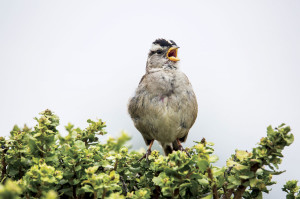We hadn’t yet reached the Gulf of the Farallones National Marine Sanctuary, but we were far enough outside the Golden Gate that Angel Island looked like an extension of the Marin Headlands, an optical illusion that kept early explorers from discovering San Francisco Bay. Joining this maiden voyage of Seaflow’s Vessel Watch Project on a Sunday morning in early May were 13 middle school students from University Preparatory Academy Charter School in San Jose.
After the captain cut the engine, Chris Garsha, an engineer from San Diego’s Scripps Institution of Oceanography, carefully lowered a small ceramic microphone over the stern. Once the hydrophone was below the waves, we listened intently to the small speaker held by eighth-grader Rachel Kirkwood. All we could hear were the waves splashing against the boat’s hull.
The Vessel Watch Project brings citizens out to the sanctuary to learn about, and listen to, underwater noise pollution generated by oceangoing vessels. It is part of Seaflow’s Sanctuaries Campaign, which aims to reduce and regulate noise in the region’s national marine sanctuaries and state marine protected areas. Each year, some 3,600 supertankers and cruise ships pass through these reserves on their way to Bay Area ports. Cumulative exposure to noise from large ships can damage hearing tissue in dolphins, whales, and fish, which in turn can affect their migration, navigation, reproduction, communication, and survival.
Seaflow Executive Director Robert Ovetz wants citizens to become the “eyes and ears of the ocean.” Getting people out on the water has an added advantage: It gives them an opportunity to see what needs protecting. Earlier that morning, as the boat passed by Kirby Cove beyond the Golden Gate Bridge, naturalist Carol Keiper pointed out the harbor porpoises feeding in the flood tide. “Chocolate kisses” she called them as their dark dorsal fins popped out of the water.
We hoped to record whale and tanker sounds that day, but encountered neither. There are never any guarantees when you’re tracking wildlife—or tankers, apparently. Although we weren’t able to hear the low-frequency “thrum-thrum-thrum” of an ocean tanker, we did drop the hydrophone to hear the “acoustic signatures” of a research vessel, a ferryboat, and a small motorboat, all loud enough to get the point across.
The “white noise” in the oceans, generated largely by the propellers of large shipping vessels, is for the most part unregulated. According to a 2006 University of San Diego study, ambient noises off the coast of California have doubled every decade for at least 40 years.
For more information about the Vessel Watch Project, go to www.seaflow.org.

.jpg)


